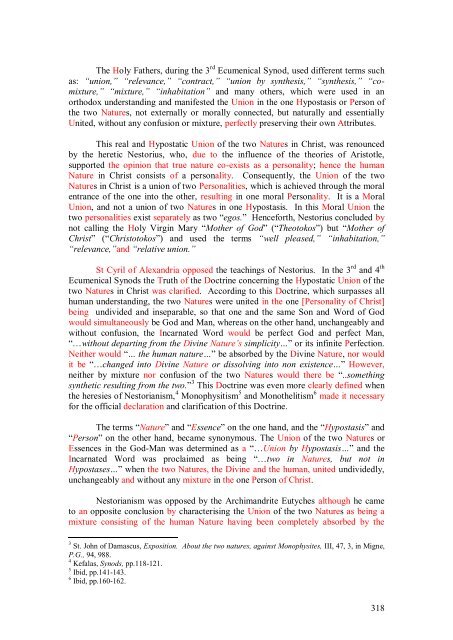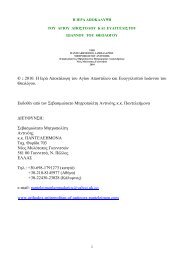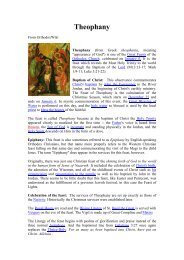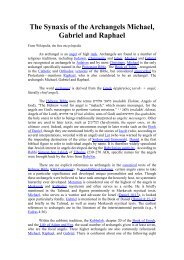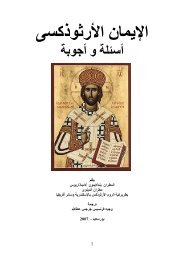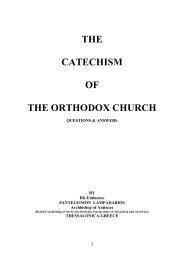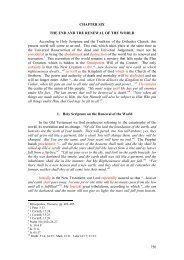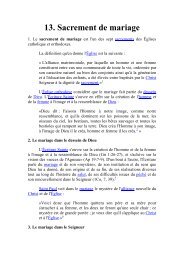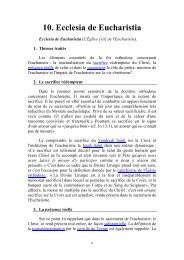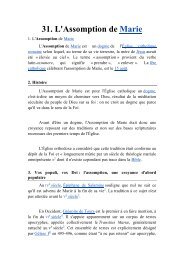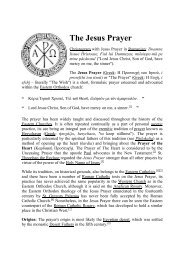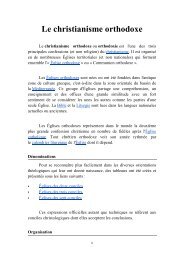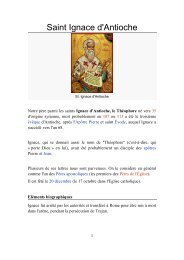028 part 3 chapter 6 the hypostatic union - Orthodox-mitropolitan-of ...
028 part 3 chapter 6 the hypostatic union - Orthodox-mitropolitan-of ...
028 part 3 chapter 6 the hypostatic union - Orthodox-mitropolitan-of ...
Create successful ePaper yourself
Turn your PDF publications into a flip-book with our unique Google optimized e-Paper software.
The Holy Fa<strong>the</strong>rs, during <strong>the</strong> 3 rd Ecumenical Synod, used different terms such<br />
as: “<strong>union</strong>,” “relevance,” “contract,” “<strong>union</strong> by syn<strong>the</strong>sis,” “syn<strong>the</strong>sis,” “comixture,”<br />
“mixture,” “inhabitation” and many o<strong>the</strong>rs, which were used in an<br />
orthodox understanding and manifested <strong>the</strong> Union in <strong>the</strong> one Hypostasis or Person <strong>of</strong><br />
<strong>the</strong> two Natures, not externally or morally connected, but naturally and essentially<br />
United, without any confusion or mixture, perfectly preserving <strong>the</strong>ir own Attributes.<br />
This real and Hypostatic Union <strong>of</strong> <strong>the</strong> two Natures in Christ, was renounced<br />
by <strong>the</strong> heretic Nestorius, who, due to <strong>the</strong> influence <strong>of</strong> <strong>the</strong> <strong>the</strong>ories <strong>of</strong> Aristotle,<br />
supported <strong>the</strong> opinion that true nature co-exists as a personality; hence <strong>the</strong> human<br />
Nature in Christ consists <strong>of</strong> a personality. Consequently, <strong>the</strong> Union <strong>of</strong> <strong>the</strong> two<br />
Natures in Christ is a <strong>union</strong> <strong>of</strong> two Personalities, which is achieved through <strong>the</strong> moral<br />
entrance <strong>of</strong> <strong>the</strong> one into <strong>the</strong> o<strong>the</strong>r, resulting in one moral Personality. It is a Moral<br />
Union, and not a <strong>union</strong> <strong>of</strong> two Natures in one Hypostasis. In this Moral Union <strong>the</strong><br />
two personalities exist separately as two “egos.” Henceforth, Nestorius concluded by<br />
not calling <strong>the</strong> Holy Virgin Mary “Mo<strong>the</strong>r <strong>of</strong> God” (“Theotokos”) but “Mo<strong>the</strong>r <strong>of</strong><br />
Christ” (“Christotokos”) and used <strong>the</strong> terms “well pleased,” “inhabitation,”<br />
“relevance,”and “relative <strong>union</strong>.”<br />
St Cyril <strong>of</strong> Alexandria opposed <strong>the</strong> teachings <strong>of</strong> Nestorius. In <strong>the</strong> 3 rd and 4 th<br />
Ecumenical Synods <strong>the</strong> Truth <strong>of</strong> <strong>the</strong> Doctrine concerning <strong>the</strong> Hypostatic Union <strong>of</strong> <strong>the</strong><br />
two Natures in Christ was clarified. According to this Doctrine, which surpasses all<br />
human understanding, <strong>the</strong> two Natures were united in <strong>the</strong> one [Personality <strong>of</strong> Christ]<br />
being undivided and inseparable, so that one and <strong>the</strong> same Son and Word <strong>of</strong> God<br />
would simultaneously be God and Man, whereas on <strong>the</strong> o<strong>the</strong>r hand, unchangeably and<br />
without confusion, <strong>the</strong> Incarnated Word would be perfect God and perfect Man,<br />
“…without de<strong>part</strong>ing from <strong>the</strong> Divine Nature‟s simplicity…” or its infinite Perfection.<br />
Nei<strong>the</strong>r would “… <strong>the</strong> human nature…” be absorbed by <strong>the</strong> Divine Nature, nor would<br />
it be “…changed into Divine Nature or dissolving into non existence…” However,<br />
nei<strong>the</strong>r by mixture nor confusion <strong>of</strong> <strong>the</strong> two Natures would <strong>the</strong>re be “..something<br />
syn<strong>the</strong>tic resulting from <strong>the</strong> two.” 3 This Doctrine was even more clearly defined when<br />
<strong>the</strong> heresies <strong>of</strong> Nestorianism, 4 Monophysitism 5 and Mono<strong>the</strong>litism 6 made it necessary<br />
for <strong>the</strong> <strong>of</strong>ficial declaration and clarification <strong>of</strong> this Doctrine.<br />
The terms “Nature” and “Essence” on <strong>the</strong> one hand, and <strong>the</strong> “Hypostasis” and<br />
“Person” on <strong>the</strong> o<strong>the</strong>r hand, became synonymous. The Union <strong>of</strong> <strong>the</strong> two Natures or<br />
Essences in <strong>the</strong> God-Man was determined as a “…Union by Hypostasis…” and <strong>the</strong><br />
Incarnated Word was proclaimed as being “…two in Natures, but not in<br />
Hypostases…” when <strong>the</strong> two Natures, <strong>the</strong> Divine and <strong>the</strong> human, united undividedly,<br />
unchangeably and without any mixture in <strong>the</strong> one Person <strong>of</strong> Christ.<br />
Nestorianism was opposed by <strong>the</strong> Archimandrite Eutyches although he came<br />
to an opposite conclusion by characterising <strong>the</strong> Union <strong>of</strong> <strong>the</strong> two Natures as being a<br />
mixture consisting <strong>of</strong> <strong>the</strong> human Nature having been completely absorbed by <strong>the</strong><br />
3 St. John <strong>of</strong> Damascus, Exposition. About <strong>the</strong> two natures, against Monophysites, III, 47, 3, in Migne,<br />
P.G., 94, 988.<br />
4 Kefalas, Synods, pp.118-121.<br />
5 Ibid, pp.141-143.<br />
6 Ibid, pp.160-162.<br />
318


